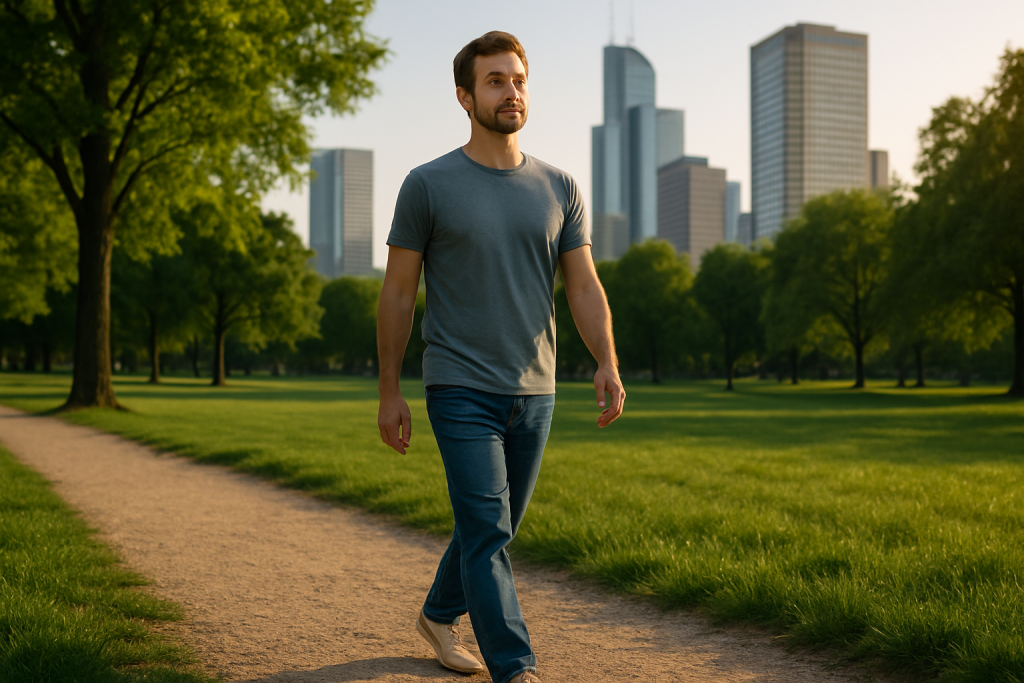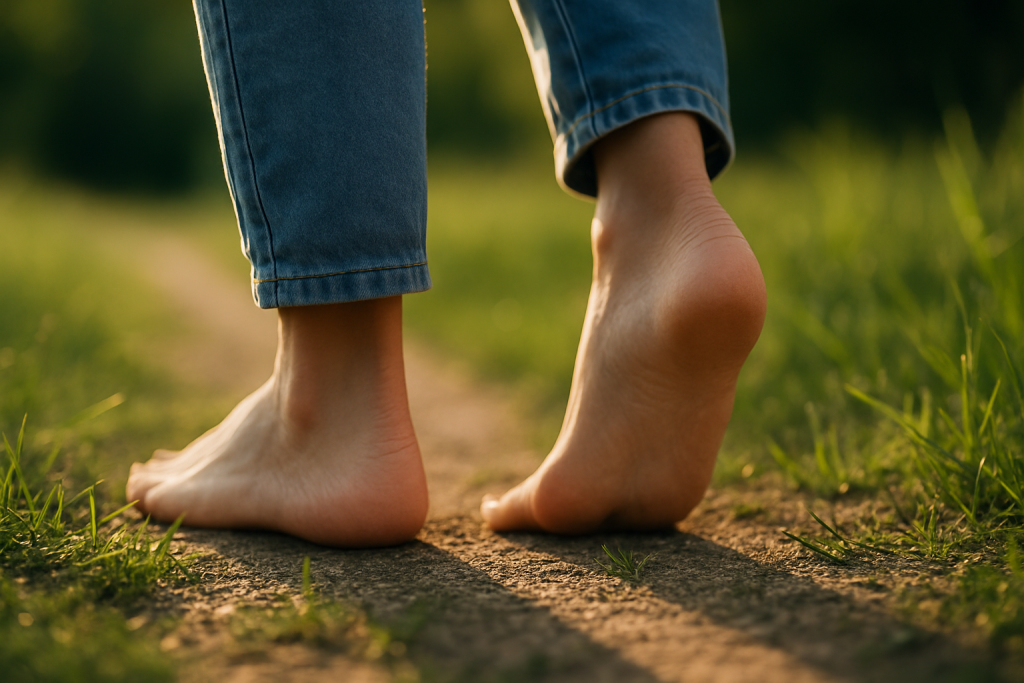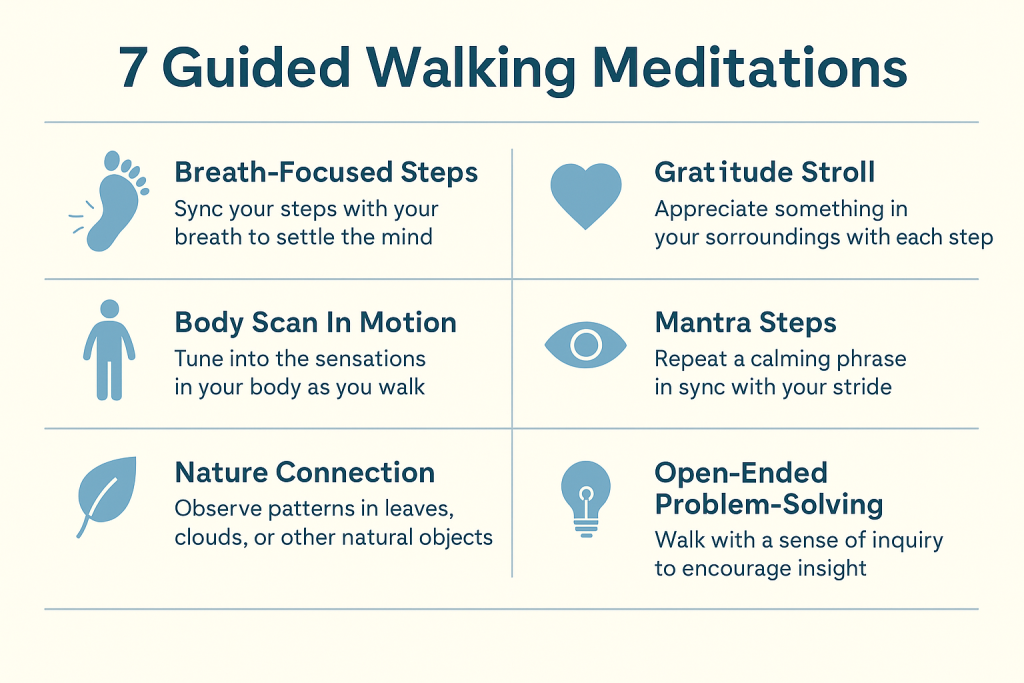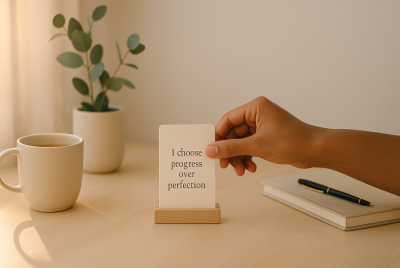7 Guided Walking Meditations to Bring Calm & Clarity Into Your Day
We may earn a commission for purchases made using our links. Please see our disclosure to learn more.
Some days, your brain feels like 20 browser tabs—notifications pinging, thoughts racing, shoulders tight. You want to meditate, but sitting still sounds like the last thing your body can handle. That’s where walking meditations shine. You bring mindfulness into motion: step, breathe, notice. It’s meditation that meets you where you are—on the sidewalk, in a park, or even pacing your hallway.
By the end of this friendly, research-backed guide, you’ll have seven guided walking meditations, simple how-tos, mindset tips, gear ideas, and a plan to make mindful walking a calm, repeatable ritual. Lace up—let’s go.
What Are Walking Meditations?
Walking meditation is mindfulness in motion. Instead of closing your eyes, you soften your gaze and let your steps become the anchor. You pay attention to breath, body sensation, and the world around you. Think of it like giving your nervous system a steady metronome—one foot, then the other—while your mind learns to settle.
Why Choose Walking Meditations?
- Accessible: No cushion, app, or special room required.
- Body-friendly: Great if sitting feels fidgety or uncomfortable.
- Flexible: Indoors or outdoors; 5 minutes or 30.
- Two benefits in one: Gentle movement + mindful presence.
Quick reframe: You’re not “too restless to meditate.” You just needed the right style.
Quick Start: A 60-Second How-To
- Stand still. Feel your feet.
- Inhale through the nose; exhale through the mouth (one cycle).
- Set a gentle pace.
- Count steps as you breathe (e.g., inhale 3 steps, exhale 3).
- When your mind wanders (it will), return kindly to step-breath-feel.
Reflection: What’s one subtle sensation you notice right now—pressure under your heel, breeze on your cheeks, or sounds in the distance?
Guided Practice #1: Breath-Focused Steps
How to Do It
Sync breath and stride: inhale for 3–4 steps, exhale for 3–4. The ratio should be adjusted to what seems right.
Why It Helps
Rhythm soothes the nervous system, making calm more repeatable.
Try This
When a worry pops up, mentally note “thinking,” then return to step… breath… step… breath.
Journal Prompt
What pace and breath count felt most natural today?

Guided Practice #2: Gratitude Stroll
How to Do It
Name one thing you’re grateful for every 5–10 steps—shoes that fit, shade from a tree, a friend who texts back.
Why It Helps
Gratitude gently retunes attention toward sufficiency and support.
Cultural Note
In Japan, shinrin-yoku (forest bathing) invites slow, appreciative walking to reduce stress and boost mood.
Reflection
What ordinary sight on your route feels like a tiny gift?
Guided Practice #3: Body Scan in Motion
How to Do It
Walk slowly and “scan” from crown to toes. Notice micro-sensations: the roll of each foot, the swing of your arms.
Why It Helps
Reconnects mind and body; eases tension you didn’t know you were clenching.
Try This
If it’s safe, try a few barefoot steps on grass or sand to heighten awareness.
Guided Practice #4: Sensory Awareness Walk
How to Do It
Spend 2 minutes per sense: sight, sound, smell, touch, even taste (crisp morning air counts).
Why It Helps
Present-moment sensory detail quiets mental noise.
Micro-Challenges
- Count five distinct sounds.
- Find three textures (bark, breeze, fabric).
- Notice light—shadows, glints, colors.
Guided Practice #5: Mantra Steps
How to Do It
Pair each step with a phrase: “Here… now…” or “Inhale… exhale…” or “I arrive… I am home.”
Why It Helps
Mantras occupy the mind kindly and interrupt rumination.
Tip
Keep your phrase short and soothing; let it ride the rhythm of your stride.

Guided Practice #6: Nature Connection
How to Do It
Let curiosity lead. Notice patterns: leaf veins, cloud shapes, ant paths. Trace lines with your eyes.
Why It Helps
Awe and attention widen perspective and soften stress.
Story Seed
I once watched sparrows share a puddle like a public bath—three minutes later, the knot in my chest had loosened. Small wonders, big medicine.
Guided Practice #7: Open-Ended Problem-Solving
How to Do It
Set a gentle intention (“I’m open to insight”), then drop it and walk with awareness. Capture ideas on a note app only after they surface.
Why It Helps
Movement boosts creativity; presence prevents over-thinking.
Safety
If you’re in traffic or crowds, prioritize awareness of surroundings first.
Make It Stick: Habit Tips That Work
- Anchor: Pair with something you already do—post-lunch stroll, dog walk, school run.
- Tiny first: Start with 5–10 minutes. Consistency > intensity.
- Cue: Same shoes, same playlist, same route—reduce friction.
- Celebrate: End with one sentence in a notes app: “Today I noticed ___.”
Analogy: Habits are like paths in a meadow—the more you walk them, the clearer they become.
Safety, Accessibility & Inclusivity Notes
- Choose routes with curb cuts, even surfaces, and lighting that match your needs.
- Use mobility aids or a slower pace—mindfulness isn’t a speed test.
- In hot or cold climates, time your walks and dress accordingly.
- If walking outdoors isn’t feasible, indoor laps or hallway pacing count.
You belong in this practice, exactly as you are.
Amazon Picks to Elevate Your Walks (Affiliate)
These are practical, widely loved items that support comfort, hydration, audio guidance, and learning. Use what serves you—ignore the rest.
New Balance 608 V5 Casual Comfort Cross Trainer
Features: Cushioned midsole, durable upper, stable heel.
Pros: Supportive for longer routes; versatile.
Cons: Heavier than minimalist shoes.
Great For: Daily city walks and mixed terrain.
What reviewers notice: Solid comfort for the price; dependable fit.
Fitbit Charge 6 Advanced Fitness Tracker
Features: Steps, HR, GPS, simple mindfulness timers.
Pros: Easy habit tracking; gentle nudge to move.
Cons: Needs periodic charging.
Great For: Seeing progress from mindful walking sessions.
What reviewers notice: Clear metrics that keep motivation up.
Bose QuietComfort Earbuds II
Features: Active noise cancellation, snug fit, rich audio.
Pros: Excellent for guided meditations in noisy places.
Cons: Premium cost.
Great For: Focused listening to walking-meditation audio.
What reviewers notice: Distraction-blocking sound quality.
Hydro Flask Standard Mouth (21 oz)
Features: Double-wall insulation; leak-resistant cap.
Pros: Cold water for hours; durable.
Cons: Heavier when full.
Great For: Hydration on sunny or humid walks.
What reviewers notice: Stays cold way longer than plastic bottles.
Walking Meditation (Book + Audio) by Thich Nhat Hanh
Features: Gentle instruction, simple practices, audio guidance.
Pros: Clear, compassionate teachings from a renowned master.
Cons: Requires a little pre-reading before your walk.
Great For: Beginners and anyone craving depth.
What readers notice: Small lessons that ripple into daily life.

Side-by-Side Comparison Table
| Product | Best For | Key Features | Pros | Cons |
| New Balance 608 V5 | Comfortable daily walks | Cushioned midsole; stable heel | Supportive; versatile | Not ultra-light |
| Fitbit Charge 6 | Tracking mindful progress | Steps, HR, GPS, timers | Motivating; clear metrics | Regular charging |
| Bose QC Earbuds II | Guided audio focus | ANC; secure fit | Blocks distractions; premium sound | Pricey |
| Hydro Flask 21 oz | On-the-go hydration | Double-wall insulation | Cold for hours; durable | Heavier full |
| Walking Meditation (Book + Audio) | Learning the practice | Instruction + audio | Compassionate, practical | Requires reading |
Research-Backed Insights
Mindful walking isn’t just “nice”—it’s effective.
- A 2018 controlled trial reported that a structured walking-meditation program significantly reduced anxiety and improved overall well-being versus regular walking; participants showed measurable gains in mood and mindfulness.
- In adults managing cardiovascular risk, walking meditation was associated with lower blood pressure and improvements in heart-rate measures—suggesting a gentle route to heart health in daily life (read the journal study summary).
FAQs
How long should a walking meditation last?
Start with 10 minutes and build to 20–30. Even 5 focused minutes can reset your day.
Do I need to walk slowly?
Not necessarily. Choose a natural, safe pace where you can stay aware of breath and sensation.
Can I listen to audio while I walk?
Yes—guided meditations or calm instrumentals help many people stay present. If you’re near traffic, keep one ear open or lower volume for safety.
Can I do walking meditations indoors?
Absolutely. Hallway laps, mall walking, or a quiet room work well—mindful attention is the practice, not the scenery.
What if I am unable to stop thinking?
That’s normal. Gently label it “thinking” and return to step, breath, feel—again and again. That return is the rep that builds mindfulness.
Helpful Resource for Step Tracking
Want a simple way to keep momentum? This pedometer watch guide explains easy, budget-friendly options to track steps and nudge daily consistency.
Conclusion
You don’t need perfect silence to find peace—you need one honest step, then another. Walking meditations invite calm into the flow of your real life: on the school run, between meetings, under trees after rain. Choose one practice—breath, gratitude, body scan, senses, mantra, nature, or open-ended insight—and try it for a week. Notice what shifts: your shoulders soften, your thoughts unclench, your world becomes a little kinder.
When life feels crowded, meet yourself outside. Breathe. Walk. Arrive. Peace is only a few mindful steps away.




